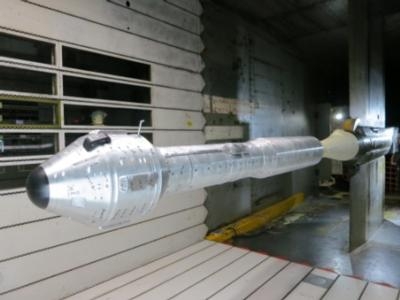Wed, Jun 05, 2013
Completes Wind Tunnel Testing Of CTS-100 Spacecraft, Atlas V Rocket
The Boeing Company of Houston, a NASA Commercial Crew Program (CCP) partner, recently performed wind tunnel testing of its CST-100 spacecraft and integrated launch vehicle, the United Launch Alliance (ULA) Atlas V rocket. The testing is part of NASA's Commercial Crew Integrated Capability (CCiCap) initiative, intended to make commercial human spaceflight services available for government and commercial customers.

Boeing and ULA also worked together to test a newly developed component of the Atlas V's Centaur upper stage. Boeing now has completed two of eight performance milestones under CCiCap and is on track to complete all 19 of its milestones around mid-2014. "The Centaur has a long and storied past of launching the agency's most successful spacecraft to other worlds," said Ed Mango, NASA's CCP manager at the agency's Kennedy Space Center in Florida. "Because it has never been used for human spaceflight before, these tests are critical to ensuring a smooth and safe performance for the crew members who will be riding atop the human-rated Atlas V."
The wind tunnel tests, which began in March and wrapped up in May at NASA's Ames Research Center in Moffett Field, CA, were the first interface tests of Boeing's spacecraft, launch vehicle adaptor and launch vehicle. A scale model of the integrated spacecraft and rocket was placed in Ames' 11-foot diameter transonic wind tunnel. The data gathered provides Boeing with critical information it needs to ensure its system is safe for launching crews to low-Earth orbit.
The Centaur liquid oxygen-feed duct line was tested in March in Murrieta, CA, to characterize how liquid oxygen moves from the stage's oxygen tank to its two engines where the propellant will be mixed with liquid hydrogen to create thrust. The Centaur, which takes over after the Atlas V first stage runs low on propellants, will push the spacecraft to its intended orbit. The Centaur has an extensive and successful history of delivering spacecraft to their destinations, including carrying NASA's Curiosity science rover to Mars. "The CST-100 and Atlas V, connected with the launch vehicle adaptor, performed exactly as expected and confirmed our expectations of how they will perform together in flight," said John Mulholland, Boeing vice president and program manager for Commercial Programs.
Boeing is one of three U.S. companies NASA is working with during CCiCap to set the stage for a crewed orbital demonstration mission around the middle of the decade.
(Image provided by Boeing)
More News
How To Get A Story On Aero-TV News/Feature Programming How do I submit a story idea or lead to Aero-TV? If you would like to submit a story idea or lead, please contact Jim Campbel>[...]
Aero Linx: International Association of Professional Gyroplane Training (IAPGT) We are an Association of people who fly, build or regulate Gyroplanes, who have a dream of a single >[...]
NORDO (No Radio) Aircraft that cannot or do not communicate by radio when radio communication is required are referred to as “NORDO.”>[...]
Also: uAvionix AV-Link, F-16 Viper Demo, TN National Guard, 'Staff the Towers' A Saturday afternoon jump run, originating from SkyDive Kansas City, went bad when it was reported th>[...]
Beyond Visual Line Of Sight (BVLOS) The operation of a UAS beyond the visual capability of the flight crew members (i.e., remote pilot in command [RPIC], the person manipulating th>[...]
 ANN FAQ: Contributing To Aero-TV
ANN FAQ: Contributing To Aero-TV ANN's Daily Aero-Linx (05.29.24)
ANN's Daily Aero-Linx (05.29.24) ANN's Daily Aero-Term (05.29.24): NORDO (No Radio)
ANN's Daily Aero-Term (05.29.24): NORDO (No Radio) Airborne 05.28.24: Jump Plane Down, Starship's 4th, Vision Jet Problems
Airborne 05.28.24: Jump Plane Down, Starship's 4th, Vision Jet Problems ANN's Daily Aero-Term (05.30.24): Beyond Visual Line Of Sight (BVLOS)
ANN's Daily Aero-Term (05.30.24): Beyond Visual Line Of Sight (BVLOS)



